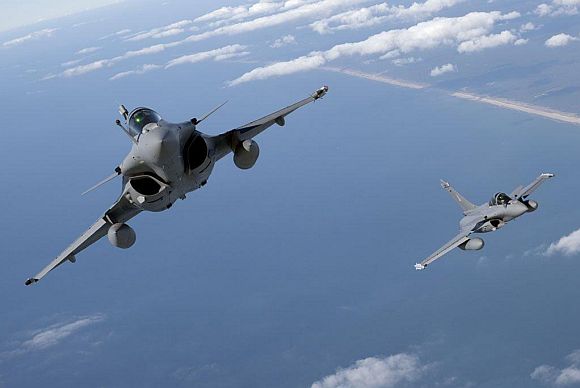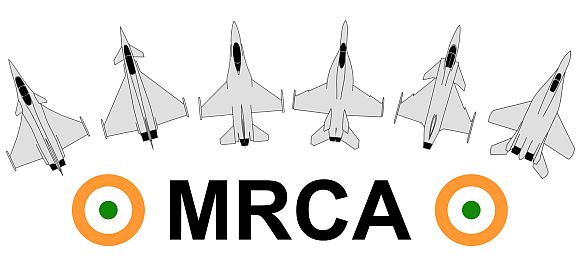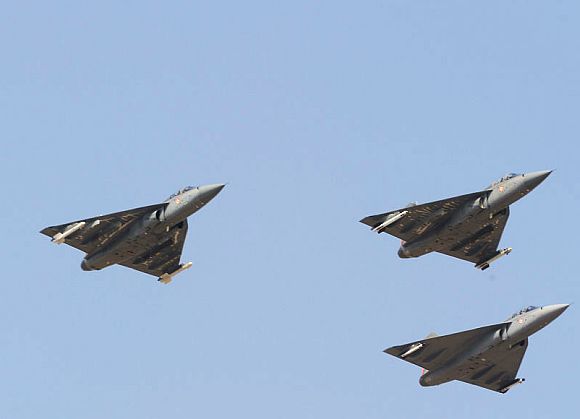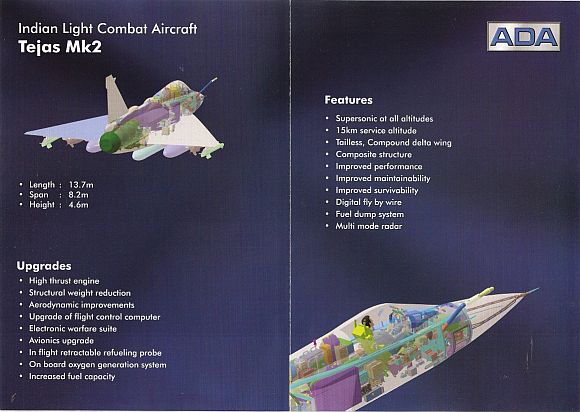 | « Back to article | Print this article |
Rafale is fine, but it's time Tejas enters MiG-21 hangar
Kudos to the government for selecting a fighter aircraft for a depleted Indian Air Force, which currently fields barely 34 fighter squadrons (21 aircraft per squadron) against an assessed requirement of 45.
While zeroing in on the French Rafale, New Delhi has said 'no thanks' to arms supply heavyweights whose political and technological clout often bludgeons procurement decisions in their favour.
This was helped, admittedly, by India's ability to soothe the losers with alternative largesse -- Washington with contracts for transport and maritime aircraft; Moscow with deals for helicopters, fighters and warships; London with trainer jets; and Stockholm with the hope of mammoth deals for artillery guns and conventional submarines.
But that should not detract from the IAF's credit for running a fair, transparent and relatively quick contest in which, for the first time in India, a detailed 'life cycle' evaluation looked beyond the fighter's ticker price to the cost of operating it through a service life of four decades.
Click on NEXT to read further...
Rafale is fine, but it's time Tejas enters MiG-21 hangar
The difficulty in conducting such an exercise is illustrated in Brazil, where competing pulls and pressures have stymied a simpler decision between the Boeing F/A-18, the Rafale and the Gripen NG fighters.
India's decision stemmed from Defence Minister AK Antony's insistence on letting the IAF determine which aircraft best met its needs. But, sadly, this unwise reliance on the views of fighter pilots alone has twisted the rationale for buying a fighter.
Instead of the cheap, single-engine, light fighter that the IAF set out to buy in the 1990s to replace India's ageing MiG-21 fleet, the IAF will have 126 heavy, twin-engine and enormously expensive Rafales.
These six squadrons of Rafales could go up to nine squadrons through a follow-on order, say IAF planners.
Add to those 12 squadrons of the Sukhoi-30MKI and another 12 squadrons of the fifth-generation fighter aircraft that India is co-developing with Russia, and the IAF will field 33 squadrons of heavy, high-performance fighters by 2022 -- 75 per cent of its 45-squadron fighter fleet.
Click on NEXT to read further...
Rafale is fine, but it's time Tejas enters MiG-21 hangar
This might gladden the heart of a young fighter pilot, just as a fleet of Ferraris would gladden the heart of a college-going youngster, even if his commute were two kilometres long through crowded traffic. But it is worrisome to a defence planner who seeks a balanced force for performing a multitude of tasks economically.
Light fighters are affordable, and cheaper to buy and to fly. Being smaller, they are inherently stealthier, less observable on enemy radars. A top-class light fighter is one-third the cost of a Rafale.
Even though the Rafale is a powerful, high-quality brute of a combat machine, it will almost always lose in a contest with three modern light fighters. "Quality is fine," said Stalin, always the pragmatist; "but quantity has a quality of its own."
That is why the USAF and the Israeli air forces have large fleets of single-engine F-16 fighters. That is also the logic for India's MiG-21 fleet and for the Tejas Light Combat Aircraft that will replace it.
Click on NEXT to read further...
Rafale is fine, but it's time Tejas enters MiG-21 hangar
In the late 1990s, whilst justifying the procurement of fighters from abroad, the IAF cited delays in the Tejas programme and suggested that the Mirage-2000 production line be bought from Dassault, and the single-engine fighter be built in India.
But when the ministry of defence, still smarting from the Tehelka exposes, insisted on a multi-vendor global tender, the IAF reframed its requirements.
The term became MMRCA (medium multi-role combat aircraft) and the specifications favoured a twin-engine, heavy fighter.
Astonishingly, nobody in the MoD seemed to notice the turnabout or object to the contradiction.
Click on NEXT to read further...
Rafale is fine, but it's time Tejas enters MiG-21 hangar
Today, India's light fighter hangars are emptying fast with replacements lagging. By 2013-14, seven squadrons of MiG-21s must retire; another six squadrons will be phased out by 2017, as will four squadrons of MiG-27s.
It is vital, therefore, to drive home the indigenous Tejas programme, committing the money, resources and organisational effort needed for developing and manufacturing at least 10-12 squadrons of progressively improved Tejas light fighters.
Compared to the estimated Rs 75,000 crore for just 126 Rafale aircraft, the Tejas's budget has been a pittance. Since 1983, Rs 9,690 crore has gone into aerospace infrastructure -- R&D laboratories, defence factories, private industry, academic institutions, and a world-class test facility, the National Flight Testing Centre -- and into building and flight-testing some 20 Tejas prototypes.
An additional Rs 4,353 crore is earmarked for the Tejas Mark II. Boosted allocations must now expand R&D facilities and up-skill the manpower that drives the Tejas programme.
Click on NEXT to read further...
Rafale is fine, but it's time Tejas enters MiG-21 hangar
Simultaneously, a world-class Tejas assembly facility must be built, incorporating the manufacturing practices and quality control measures that characterise aircraft production worldwide.
Currently, the Tejas's manufacture is the responsibility of Hindustan Aeronautics Limited, which has been without a CEO since Ashok Nayak retired last October. With HAL's focus on ongoing production lines like the Sukhoi-30MKI, Tejas assembly is hardly a priority.
Nor is there emphasis on reducing manufacturing cost, which is currently too high at Rs 180-200 crore ($36-40 million) per Tejas Mark I. That must be brought down to Rs 125-150 crore ($25-30 million) to make the LCA a compelling buy on the international market. Export orders would allow scale manufacturing, driving down prices further.
Paying Rs 75,000 crore for the Rafale will indeed boost national defence. But a far smaller expenditure on the Indian aerospace establishment, and the squeezing of key technologies from Dassault and Thales during contract negotiations, will ensure that the Rafale is the last fighter that India buys abroad.
Click on NEXT to read related feature...






